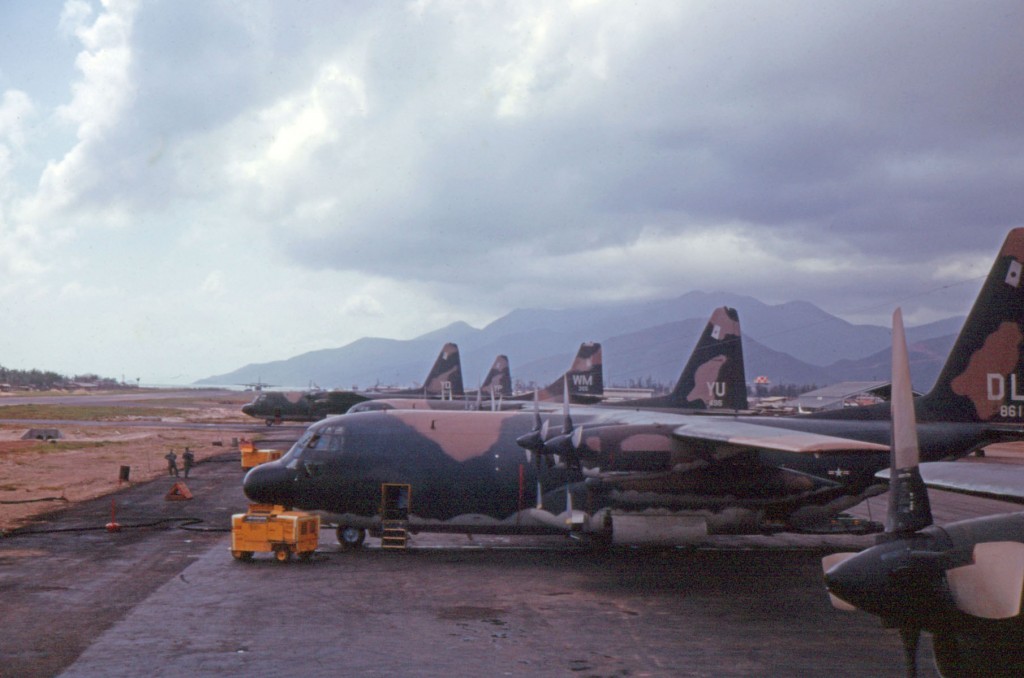Fire in Flight – Page 2.
June 25th, 1968, started off like any other day in-country on the shuttle run. Up early, meeting in ops, check out the frag order, which was basically an itinerary and cargo manifest for that day. Part of the briefing included an intelligence rundown of the potential hot spots or enemy activity around each of the airports on our frag. We would usually have aerial photographs of the runways and approaches so we could visualize how we might be making our arrival based on current conditions. I had developed this technique where we would arrive over our destination as high as possible (usually 4,500 feet above ground would be enough to avoid small-arms fire), we would make a steep, spiraling approach and roll out on a high final and then slip the aircraft down to the runway threshold. This had worked extremely well for me. The C-130 has a massive rudder/vertical stab combination, and in a full slip would come out of the sky like a falling grand piano. The trick was to kick it out at just the right point to stop the downward momentum and reestablish a normal approach. When you landed at about 10 of these hot spots every day, you soon learned to become resourceful in order to minimize your chances of getting hit. Anyway, it worked for me--I would have probably been roundly criticized by the powers that be, or maybe not. But I didn't care, you did what you had to do.

Fig. 2 - Our airplane on the ramp at Qui Nhon on an earlier flight. Qui Nhon is very close to Nha Trang on the S. Vienamese coast. Notice the tail number: 62-1861
According to my logbook entry for 25 June, we had an early-morning departure out of Tuy Hoa for Nha Trang. At Nha Trang, a coastal base situated about in the middle of the country, we would have probably been standing around watching the cargo being off loaded and the new load added on. From Nha Trang we flew to Kontum, another military outpost on the high plateau in the center of the country. Departing Kontum, we made our way down south to Katum, a remote outpost very near the Cambodian border and about 40 miles northwest of Saigon. Katum was always a destination that merited special attention because of its proximity to the entry point of the Ho Chi Minh trail into S. Vietnam. To say that Katum was a hot spot would be an understatement; it always seemed to be under siege, and this day was no exception. Anyway, there seemed to be an underlying sense of urgency about the day's flights into Katum.
So when we arrived at Katum it was about 10 a.m., but the ground fog had not totally burned off yet. As we flew over the field, we could look down and see the runway, but we knew, of course, that on final we would encounter very low visibility and probably not see the runway. There were a couple of other C-130s trying to land, not having much success. I noticed there was a break in the overcast about 8 miles south, which we knew was in the vicinity of the abandoned Prek Lok airfield. I discussed this with my copilot, Britt Blaser, and navigator, Jon Alexander. Jon pointed to a road on the chart that led from Prek Lok to Katum.
Britt and I discussed the possibility of descending through the hole and possibly working our way up to Katum below the cloud deck. Today, we call that "scud running" and it's definitely not a good idea, but this was wartime, and you made adjustments. Britt made the radio call to our forward air controller, call sign "Allen Alpha," and also advised the other aircraft of our intentions. Apparently there was no radio contact on the ground at Katum the entire day. We spiraled down through the hole and were able to determine that we could get below the clouds at about 300 feet AGL (above ground level). We followed the road up to Katum, circled the field, and were able to land OK. We improvised.
The troops on the ground told us to expect a mortar attack since there were "hostiles" in the area that routinely fired whenever fixed-wing aircraft landed. C-130s were known as "mortar magnets" anyway, so we were not surprised. The troops said they had taken rounds every day for the past week. So we on-loaded our cargo, which consisted of equipment and personnel, and made a routine departure on runway 16. We had landed the opposite way, on runway 34. It just made sense to depart over the same route you arrived over if you hadn't taken any hits.
We made the short flight over to Tay Ninh to off-load, about an 8-minute flight. Little did we know we would be crashing on this very same runway in a matter of hours.